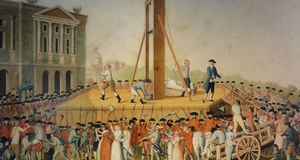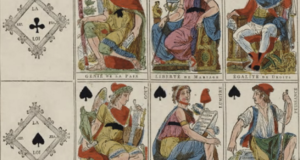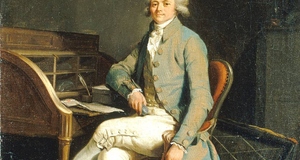Political and Social Change and its Depictions in 19th Century French and English Caricature: Decapitation, Dismemberment, and Defecation
By
2011, Vol. 3 No. 08 | pg. 2/2 | « This use of scatological imagery is further exemplified in David’s The English Government (fig.5). Here, the English government is depicted as a Devil-like figure, with its buttocks assuming the likeness of King George III. The King’s mouth (anus) then vomits explosively onto its people a series of taxes. David’s image is anti-monarchical by suggesting that the common people are overwhelmed by the King’s imposed policies. The monarch has further been vilified through its placement upon the Devil’s buttocks—David has quite literally made an arse out of the king. Though this, David has exposed and dehumanised the subject, exposing the weakness of the monarchic system of government, and has used this device to question the authority of the King himself.16 This widespread proliferation of political caricature and graphic satire leads to the point next point of censorship. As a result of the perceived threat to established monarchical authority, a push was made by government to censor graphic satire. Between 1830-1835, severe press laws were reinstated, laws that made press attacks against monarchic authority, or the king’s person punishable by fines, imprisonment, or both. This however did not quell attacks by caricaturists, yet instead provoked them further. The implication of censorship can then be seen to be an example of social change provoked by caricature.17 Following the passing of the Civil Constitution of the Clergy in 1790, a second key issue began to emerge in French caricatural representation. As church land was nationalised/confiscated in France in an attempt to reorganise the church according to principles of equality, the Catholic Church became associated with the monarchic government. Caricatural focus then began to shift its attention towards the pope and the clergy. The Patriotic Fat Remover (fig.6) and The Priest of Yesterday-The Priest of Today (fig.7) demonstrate an increase of caricatures poking fun at the reduced status of the clergy. The clergy is first depicted as a portly, richly dressed priest being led towards a press where he will be forced to surrender his wealth.The Church is first lampooned as a wealthy and greedy organisation through the evocation of excess through the priest’s corpulence, demonstrating the promotion of this perception of the Church through caricature. Secondly, the State is sent up as a money-hungry establishment through their use of arcane methods to extract wealth through the clergy, in the form of a press. The Church is displayed to be under the power of the State. In the following image (fig.7), the transformation/reform is complete, as demonstrated by the comparative structure of the illustration. The once obese priest has now been reduced to an almost skeletal figure, and the difference is best seen in the difference between their hands. The larger priest is unable to join his hands together and pray due to an obstruction in the form of his stomach (greed), where the smaller figure can join his hands together, in a way more suited to the function of his office. This demonstrates a promotion through caricature of a shifting perception of the church. In addition to being portrayed as “victim” to a gluttonous monarchy, the Church was further portrayed as a great purveyor of hypocrisy, and a figure of failure. Arrival of the Pope in Hell (fig.8) depicts Pope Pius VI being welcomed to hell by devils for his inability to uphold the laws of Saint Peter. The image of church authorities burning in hell served as a common image within caricature, as the theme worked to turn the tables on religious leaders who used the threat of eternal damnation upon others as a means of securing their own power. Here religious leaders have been subjected to the very punishment they preached, questioning the validity of papal decree and church authority within wider society. 18 Caricature served as a distinguishing feature of the revolutionary character, and played an active part as a promoter and instigator of social, political and artistic change within the public spotlight. It has been demonstrated that through means of graphic satire, caricature was a central purveyor of public opinion regarding the changing role of the monarch, and the differentiation between church and state. Endnotes1.) Melot, Michel (1988), ‘Caricature and the Revolution: The Situation in France in 1789’ in French Caricature and the French Revolution, 1789-1799, Los Angeles, Grunwald Center for the Graphic Arts. p. 26 2.) Cuno, James (1988), ‘Introduction’ in French Caricature and the French Revolution, 1789-1799, Los Angeles, Grunwald Center for the Graphic Arts. - “[chronologically] the parameters of the Revolution can justifiably extend from 1787-1815. The years 1789-1799, however, mark a significant break in the administrative centralization of French politics and frame a struggling, highly controversial experiment in the democratization of French society.” p.13 3.) Melot, Michel (1988), ‘Caricature and the Revolution: The Situation in France in 1789’ in French Caricature and the French Revolution, 1789-1799, Los Angeles, Grunwald Center for the Graphic Arts. 4.) Melot, Michel (1988), p.26 5.) Boime, Albert, (1992) ‘The Sketch and Caricature as Metaphors for the French Revolution’ in Zeitschrift für Kunstgeschichte, 55 Bd., H. 2, pp. 256-267 [online]. Available: http://www.jstor.org/stable/1482613 [Accessed: 24/10/2010] 6.) Cuno, James (1988), p. 16 7.) Melot, Michel (1988), p. 29 8.) Melot, Michel (1988), p. 28 9.) Cuno, James (1988), p. 14 10.) Cuno, James (1988), p. 17 11.) Freud, Sigmund (1960), Jokes and Their Relation to the Unconscious, trans. James Strachey, New York, W.W. Norton. Cited Cuno, James (1988), p. 16 12.) Cuno, James (1988), p. 17 13.) Paulson, Ronald (1988), ‘The Severed Head: The Impact of French Revolutionary Caricatures on England’ in French Caricature and the French Revolution, 1789-1799, Los Angeles, Grunwald Center for the Graphic Arts. p. 64 14.) Paulson, Ronald (1988), p. 58 15.) Childs, Elizabeth, (1992), ‘Big Trouble: Daumier, Gargantua, and the Censorship of Political Caricature’ in Art Journal, Vol. 51, No. 1, Uneasy Pieces, pp. 26-37 [online]. 16.) Burlingham and Cuno (1988), ‘Catalogue of the Exhibition’ in French Caricature and the French Revolution, 1789-1799, Los Angeles, Grunwald Center for the Graphic Arts. pp. 218-219 17.) Childs, Elizabeth, (1992) 18.) Burlingham and Cuno (1988), pp. 176-177 Suggested Reading from Inquiries Journal
Inquiries Journal provides undergraduate and graduate students around the world a platform for the wide dissemination of academic work over a range of core disciplines. Representing the work of students from hundreds of institutions around the globe, Inquiries Journal's large database of academic articles is completely free. Learn more | Blog | Submit Latest in History |
















